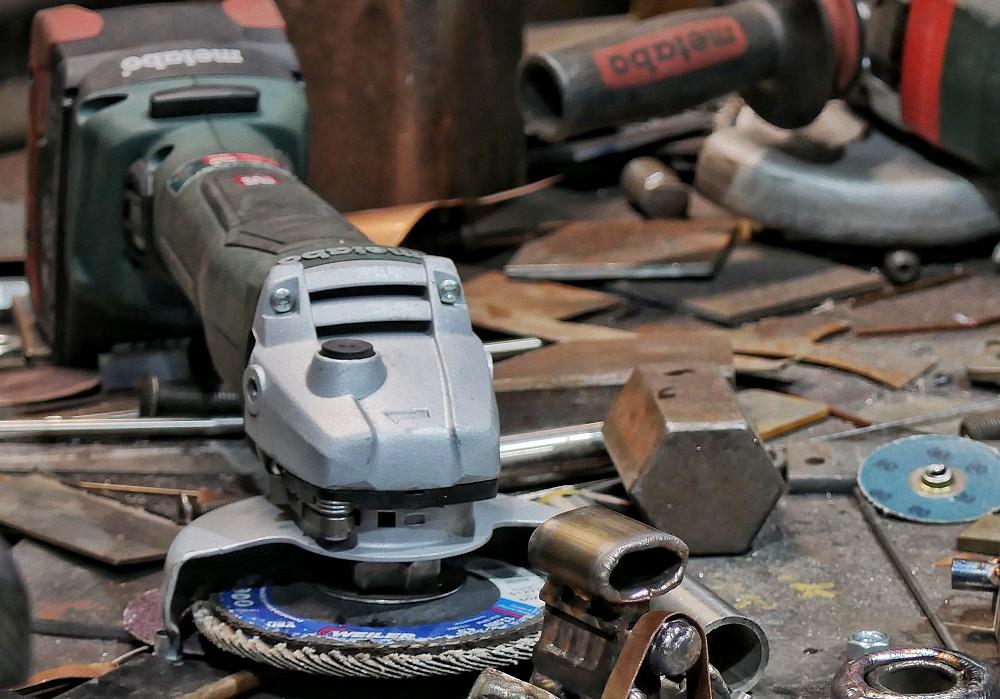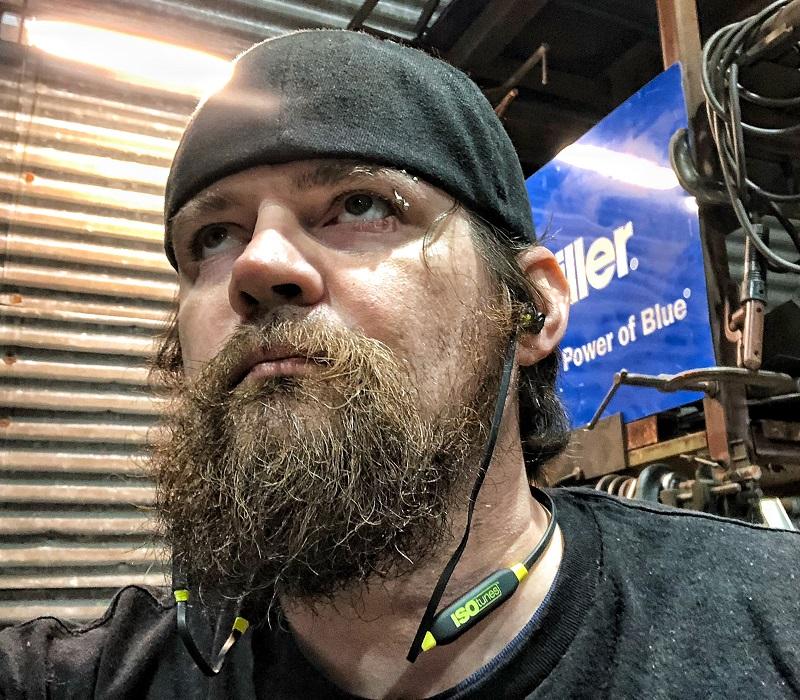Owner, Brown Dog Welding
- FMA
- The Fabricator
- FABTECH
- Canadian Metalworking
Categories
- Additive Manufacturing
- Aluminum Welding
- Arc Welding
- Assembly and Joining
- Automation and Robotics
- Bending and Forming
- Consumables
- Cutting and Weld Prep
- Electric Vehicles
- En Español
- Finishing
- Hydroforming
- Laser Cutting
- Laser Welding
- Machining
- Manufacturing Software
- Materials Handling
- Metals/Materials
- Oxyfuel Cutting
- Plasma Cutting
- Power Tools
- Punching and Other Holemaking
- Roll Forming
- Safety
- Sawing
- Shearing
- Shop Management
- Testing and Measuring
- Tube and Pipe Fabrication
- Tube and Pipe Production
- Waterjet Cutting
Industry Directory
Webcasts
Podcasts
FAB 40
Advertise
Subscribe
Account Login
Search
Metal fabricators: Embrace the power of going wireless
From wireless tools to wireless headphones, cutting the cord makes metalworking easier and safer
- By Josh Welton
- January 4, 2020

Detroit welder loves his Metabo angle grinders. But his latest grinder is different from the other Metabos he owns: It’s battery-powered. Welton explains why more metal fabricators should embrace wireless technology. Photo by Josh Welton
To those amongst us who proclaimeth they hath never cut, torched, nor yanked a tool’s cord into oblivion, I denounce thee as bearing false witness. If thou hath never exclaimed “damn thee!” toward thine feet as thou once again tripped over a TIG machine’s foot pedal cord, thou speaketh not the truth. If thou not once had a pair of earbuds pulled from thine ear as their wires caught on a workbench vise, thou art lucky.
Now that we’re done having flashbacks to our middle school studies of Shakespeare, let’s move forward to what is truly a revolution in the blue-collar trades: the power of cutting the cord.
Depending on your age, you’d remember these following lines repeated by either former puppet Pinocchio or the newly sentient Ultron:
“I’ve got no stringsTo hold me down,To make me fret, or make me frown.I once had strings, but now I'm free... There are no strings on me!”
Either way, same point: Strings, or cords, or wires, or whatever you might refer to them get in the way of freedom.
Back when Miller Electric came out with its wireless foot pedal, I wasn’t necessarily in a hurry to get one. I was somewhat afraid there would be a lag between the pedal and the signal receiver that plugged into my Dynasty 280DX, but mostly I thought, What do I need it for? I wasn’t crawling into cages or through a labyrinth of tubing on a job site. I was mainly welding at my workbench. Then Miller sent me one to try.
It was one of those things where a few days later it dawned on me: Whoa! I haven’t tripped over a cord in three days! I hadn’t fought with the pedal as I moved it from one side of the table to the other. There was no entanglement with other cords or hoses. I didn’t need to wrap it up when it was time to sweep. All in all, it just took out a bunch of little issues that would frustrate me throughout the workday. And the pedal did what my foot told it to do.
At the beginning it felt like there might have been a slight lag, but either that was in my head or it’s been fixed since then. It doesn’t exist now. I even convinced the defense prototype shop I work at to use them. In a shop with multiple welding machines, the pedal/receivers have enough unique frequencies to operate without interfering with each other. The remote pedal is easy to take inside of vehicles or to move around surface plates or the large Acorn table we use.
Now, I’ve written before about my beloved Metabo angle grinders, specifically the 6-in. one that I’ve owned since I was first an apprentice in 2002. More recently my collection has grown to include a couple more of the newer, corded models that pack a bunch of cool technology like torque reserve, vibration damping, safety clutches, and fast brakes. My latest grinder is different from the other Metabos I own: It’s battery-powered.
Battery technology continues to improve, making cordless power tools a viable reality. At first glance I figured this new 4 ½-in. grinder would come in handy when there was no power source available at a job site or I didn’t feel like unwrapping an extension cord. I assumed that when I was at my workbench in my shop the corded grinders would remain my go-to and the cordless grinder would stay in its case with the batteries charging on their supersweet air-cooled charger, but It didn’t take long for that assumption to change.
With its 18-volt lithium high-density batteries featuring a large 5.5-Ah capacity, the grinder does not lack for power or durability. The work time between charges varies with use, but it’s long enough that it’s never an issue. That bad-ass air-cooled charger prevents the battery from warming up and allows for longer life. And despite the big battery hanging off the end, the grinder is so well-balanced that it doesn’t feel heavy at all.

Josh Welton listens to music and podcasts on wireless ISOtunes headphones, which are also OSHA approved. Photo by Josh Welton
The performance is outstanding. Part of that is due to the brushless motor. This is not a new technology, but it’s become more affordable and thus more suitable for these types of applications and trickling down to everyday tools. It’s a very efficient motor. If you’ve ever wondered why a power tool is classified as “smart,” it’s because the brushless motor senses what it needs to get the job done. Rather than going after everything at a 10, it senses resistance and adjusts power as needed from 1 through 10. This grinder performs as well if not better than its plugged-in brethren but without another cord to get in my way. It has become my go-to grinder and is definitely the future of tools.
It wasn’t long ago that to listen to music or podcasts in the shop you needed to snake the wires of your earbuds down through your shirt into the phone in your pants pocket. It was kind of a hassle. If the cord was too long, it had to be bunched up in that pocket or hang loose and catch on random things you walked by. If it was too short, it just kept yanking the buds out of your ear or the wire out of your phone. Now we have Bluetooth wireless sound, and it’s awesome.
The trades environment, however, is a rough place for electronics. I’ve gone through dozens of both wireless (where the wire exists only from ear to ear) and true wireless (where there are the two earbuds and zero wires) versions from Bragi, Jabra, Jaybird, Beats, and so on. They’ve performed all over the spectrum. Some acquitted themselves nicely, but I’ve always felt there would be a market for Bluetooth earbuds made for the blue-collar worker. Plugfones had the right idea, but they didn’t feel substantial, and neither the pair I started with nor the replacement pair work consistently. That being said, it does seem as though they are continuing to develop and evolve their technology and hopefully build quality.
This past April ISOtunes sent me a pair to review, the Xtra. ISOtunes, in my opinion, has hit the nail on the head. It even had a booth at FABTECH this year. These earbuds are built for battle. The foam ear inserts screw in, the USB charging port has a cover to keep debris out when not charging, they have ANSI-certified noise reduction, a max decibel limit, and are 100% OSHA-approved. The eight hours of use rating is pretty accurate. I’ve never had an issue with connectivity. The one complaint I’ve ever had is that they can be too quiet, but that’s actually by design. Part of being safety-rated is not blowing out your eardrums, and the other is letting just enough ambient noise in to save you from getting run over by a hi-lo you otherwise couldn’t hear coming.
Looking back on my career, I still cringe when I think about the times I dropped a piece of angle iron on my angle grinder cord or rolled a gas bottle over a foot pedal’s wire or had my earbuds yanked out of my head when the wire got caught on the corner of a layout table.
I don’t know if the revolution will be televised, as the late Gil Scott-Heron warned us about. But I can assure you it won’t be dragging cords.
subscribe now

The Fabricator is North America's leading magazine for the metal forming and fabricating industry. The magazine delivers the news, technical articles, and case histories that enable fabricators to do their jobs more efficiently. The Fabricator has served the industry since 1970.
start your free subscriptionAbout the Author

Related Companies
- Stay connected from anywhere

Easily access valuable industry resources now with full access to the digital edition of The Fabricator.

Easily access valuable industry resources now with full access to the digital edition of The Welder.

Easily access valuable industry resources now with full access to the digital edition of The Tube and Pipe Journal.
- Podcasting
- Podcast:
- The Fabricator Podcast
- Published:
- 04/16/2024
- Running Time:
- 63:29
In this episode of The Fabricator Podcast, Caleb Chamberlain, co-founder and CEO of OSH Cut, discusses his company’s...
- Trending Articles
AI, machine learning, and the future of metal fabrication

Employee ownership: The best way to ensure engagement

Steel industry reacts to Nucor’s new weekly published HRC price

Dynamic Metal blossoms with each passing year

Metal fabrication management: A guide for new supervisors

- Industry Events
16th Annual Safety Conference
- April 30 - May 1, 2024
- Elgin,
Pipe and Tube Conference
- May 21 - 22, 2024
- Omaha, NE
World-Class Roll Forming Workshop
- June 5 - 6, 2024
- Louisville, KY
Advanced Laser Application Workshop
- June 25 - 27, 2024
- Novi, MI



























